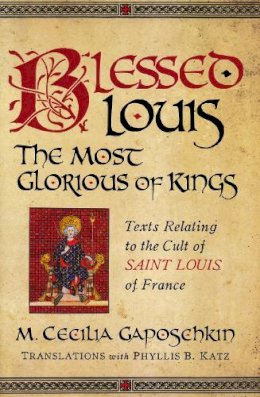
Stock image for illustration purposes only - book cover, edition or condition may vary.
Blessed Louis, the Most Glorious of Kings: Texts Relating to the Cult of Saint Louis of France (ND Texts Medieval Culture)
M. Cecilia Gaposchkin
FREE Delivery in Ireland
Description for Blessed Louis, the Most Glorious of Kings: Texts Relating to the Cult of Saint Louis of France (ND Texts Medieval Culture)
Paperback. With the aim of showing Saint Louis as he was commemorated in the literature of the Middle Ages, this book presents six previously untranslated texts: two little-known but early and important vitae of Saint Louis; two unedited sermons by the Parisian preacher Jacob of Lausanne (d. Series: Notre Dame Texts in Medieval Culture. Num Pages: 360 pages. BIC Classification: 1DDF; HBJD; HBLC1; HRCC7; HRCR. Category: (G) General (US: Trade). Dimension: 236 x 155 x 23. Weight in Grams: 512.
Louis IX, king of France from 1226 to 1270 and twice crusader, was canonized in 1297. He was the last king canonized during the medieval period, and was both one of the most important saints and one of the most important kings of the later Middle Ages. In Blessed Louis, the Most Glorious of Kings: Texts Relating to the Cult of Saint Louis of France, M. Cecilia Gaposchkin presents six previously untranslated texts that informed medieval views of St. Louis IX: two little-known but early and important vitae of Saint Louis; two unedited sermons by the Parisian preacher Jacob of ... Read moreLausanne (d. 1322); and a liturgical office and proper mass in his honor—the most commonly used liturgical texts composed for Louis’ feast day—which were widely copied, read, and disseminated in the Middle Ages.
Gaposchkin’s aim is to present to a diverse readership the Louis as he was known and experienced in the Middle Ages: a saint celebrated by the faithful for his virtue and his deeds. She offers for the first time to English readers a typical hagiographical view of Saint Louis, one in counterbalance to that set forth in Jean of Joinville’s Life of Saint Louis. Although Joinville’s Life has dominated our views of Louis, Joinville’s famous account was virtually unknown beyond the French royal court in the Middle Ages and was not printed until the sixteenth century. His portrayal of Louis as an individual and deeply charismatic personality is remarkable, but it is fundamentally unrepresentative of the medieval understanding of Louis. The texts that Gaposchkin translates give immediate access to the reasons why medieval Christians took Louis to be a saint; the texts, and the image of Saint Louis presented in them, she argues, must be understood within the context of the developing history of sanctity and sainthood at the end of the Middle Ages.
Show Less
Product Details
Publisher
University of Notre Dame Press
Series
Notre Dame Texts in Medieval Culture
Place of Publication
Notre Dame IN, United States
Shipping Time
Usually ships in 7 to 11 working days
About M. Cecilia Gaposchkin
M. Cecilia Gaposchkin is associate professor of history at Dartmouth College.
Reviews for Blessed Louis, the Most Glorious of Kings: Texts Relating to the Cult of Saint Louis of France (ND Texts Medieval Culture)
"With this collection of Latin texts and facing page English translations, Cecilia Gaposchkin and Phyllis Katz offer a valuable treasure to scholars and students of medieval Europe—the hagiographic, liturgical, and homiletic texts that actually played a role in shaping the memory of the sainted king of France, Louis IX. For too long, we have been mesmerized by the eloquent words ... Read moreof the privileged noble, Jean de Joinville, whose memoir had no impact at all during the Middle Ages. Gaposchkin and Katz help to break Joinville’s spell, and thus to place us much closer to the ways in which late medieval people perceived and remembered Saint Louis." —Sharon Farmer, University of California, Santa Barbara "With Blessed Louis, the Most Glorious of Kings, M. Cecilia Gaposchkin makes a groundbreaking contribution to the fields of medieval history, hagiography, and historical memory. Of the five main texts she edits and translates here, four are appearing in print for the first time, and none has ever before been translated into English. These exciting new texts give us a fresh understanding of how Saint Louis was represented in the century after his canonization." —Sean L. Field, University of Vermont "Joinville's portrait of his royal friend Louis IX remains understandably appealing to modern readers, but the Roman Church did after all canonize the king, and it is from the texts gathered here that we gain valuable insight into how members of the royal court and of the Franciscan and Dominican orders, some of whom had labored on behalf of his canonization, remembered and honored Saint Louis in the first few generations following his death." —Lester K. Little, Smith College “Gaposchkin introduces the reader to the hagiographical tradition of St. Louis, the manuscript tradition of these particular texts, and the themes that featured so prominently in these early lives: his humility and other virtues, devotion to the cross and relics, his ascetic practices, his crusading and, of course, the divine providence and protection during his life and the miracles that were immediately reported after his death.” —H-France Review “An extraordinarily rich and useful resource to scholars working on Saint Louis as well as on medieval hagiography and the cult of saints. . . . A treasure trove of information.” —Renaissance Quarterly “This collection of primary texts offers readers a vivid sense of the various hagiographic and liturgical materials that might have formed part of the devotional tradition surrounding a saint in the later Middle Ages. . . . this collection makes accessible to a wide range of people a vibrant and rich portrait of medieval devotion to Saint Louis.” —Renaissance and Reformation Show Less

